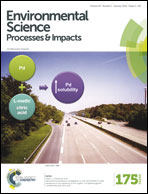Oceanic source strength of carbon monoxide on the basis of basin-wide observations in the Atlantic†
Abstract
We measured the carbon monoxide (CO) concentrations in the marine boundary layer and the surface waters of the Atlantic Ocean from 50°N to 50°S during the UK Atlantic Meridional Transect expedition (AMT-7) in October 1998, covering the open ocean and coastal regions. Throughout the cruise track, atmospheric CO concentrations continually decreased southwards in the northern hemisphere with sporadic low and high concentrations encountered. South of the intertropical convergence zone (ITCZ) atmospheric CO was enhanced by ∼10 ppb compared to north of the ITCZ due likely to biomass burning emissions prevailing in the tropical continents. The remainder of the southern hemisphere remains nearly invariable except for the vicinity of Rio de la Plata. The surface seawater was supersaturated everywhere along the track and its saturation anomaly oscillated up to 90, exhibiting a typical diurnal cycle. The maximal dissolved CO concentration in the diurnal cycle appeared 2–5 hours behind the local maximum of solar insolation in the open ocean and the time lag further increased in the coastal region. The global ocean flux of CO to the atmosphere was estimated to be 14 Tg(CO) a−1 within the range of 4–24 Tg(CO) a−1. This is within uncertainty almost identical to what was estimated on the basis of the basin-wide observations in the Pacific and the Atlantic, but more than ∼4 times lower than the values appeared in the Intergovernmental Panel on Climate Change (IPCC) reports.


 Please wait while we load your content...
Please wait while we load your content...